Into the West, a weekend
Now with the springtime
the days will grow longer
and after St Bride’s day
My sail I’ll let go
I put my mind to it
And I never will linger
Till I find myself back
in the County Mayo
Frank O’Connor, a great Irish prose writer, translated this poem of Gaelic poet, Antoine O’Raifteiri, from the native Gaelic tongue, and however great the translation, it does neither O’Raifteiri nor Mayo, any justice or favours.
Here are the students of Gaelic from the University of California, Berkeley, giving their rendition of that first verse in Raftery’s great poem, itself a sort of travelogue, composed by the poet, himself a wandering bard, as he makes his way to Mayo.
https://www.youtube.com/watch?v=3syN2hf8tMU
Mayo, on the west coast of Ireland, but my usual destination and point of departure from there during my sojourn, is the town of Westport or, as its known in Gaelic, Cathair na Mart, the Town of the Markets. My first stop there is always Matt Molloy’s pub, where the finest traditional Irish music in Ireland can be heard, seven days a week.
 Surrounding Westport and dominating all the west coast of Ireland are the most beautiful mountains and breathtaking valleys.
Surrounding Westport and dominating all the west coast of Ireland are the most beautiful mountains and breathtaking valleys.
There isn’t an inch of this countryside without a complex historical tale and there’s none more than The Lost Valley and the tragedy of Doolough.
On Friday 30 March 1849 two officials of the Westport Poor Law Union arrived in Louisburgh to inspect those people in receipt of outdoor relief in order to verify that they should continue to receive it. For some reason the inspection did not take place and the officials went on to Delphi Lodge – a hunting lodge – twelve miles south of Louisburgh. The people who had gathered for the inspection were thus instructed to appear at Delphi Lodge at 7am the following morning if they wished to continue receiving relief. For much of the night and day that followed therefore seemingly hundreds of destitute and starving people had to undertake what for them, given their existing state of debilitation, was an extremely fatiguing journey, in very bad weather. A letter-writer to “The Mayo Constitution” reported shortly afterwards that the bodies of seven people, including women and children, were subsequently discovered on the roadside between Delphi and Louisburgh overlooking the shores of Doolough lake and that nine more never reached their homes. Local folklore maintains the total numbers that perished because of the ordeals they had to endure was far higher.

There’s an inscription from Mahatma Ghandhi at the memorial cross in the Los Valley that reads, How can men feel themselves honoured by the humiliation of their fellow beings?
Our day was not all sad memories though as we soon reach the tiny town of Lehane where much of Jim Sheridan’s film adaptation of JB Keane’s play, The Field was shot. Of course, we had to stop there in Gaynor’s pub for refreshment. And this is the view from there of the Killary Fjord, the only fjord in Ireland.

Just before we reached Lenane, myself and my travel companion, local social worker Maria McGoldrick, stopped in Eriff forest, the last remaining ancient oak forest in Ireland. Here are are a few shots from the Eriff forest.

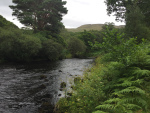


We stopped again, on our way to Clifden, further south, attracted by a road side stalling selling fresh oyster and mussels from Killary Harbour, produced, as it happened, by Maria’s own cousin, Kate and her husband, Simon.
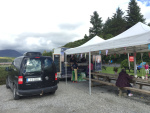
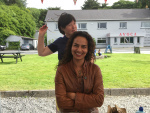
After that, it was just one breathtaking view after another. Like Kylemore Abbey, a massive dwelling owned by Benedictine nuns since 1920, that once belonged to an English lord who had to sell for gambling debts.
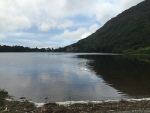
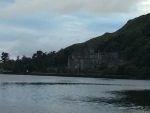
Now this view of Kylemore Abbey is spectacular but it was the view on the other side of the road that really got me.


By the time we got to Clifden, we were hungry and thirsty, Kate’s delicious roadside oysters notwithstanding, so we had a scout around this busy town that, in summer, according to the locals, the Irish are outnumbered by the French.
We settled on Marconi’s in Foyle’s Hotel and marvelled at a painting in the dining room that entertained us, throughout. See if you can name any of the bizarre mixture of people, here depicted.



Postcard from a Pigeon
- Dermott Hayes's profile
- 4 followers



